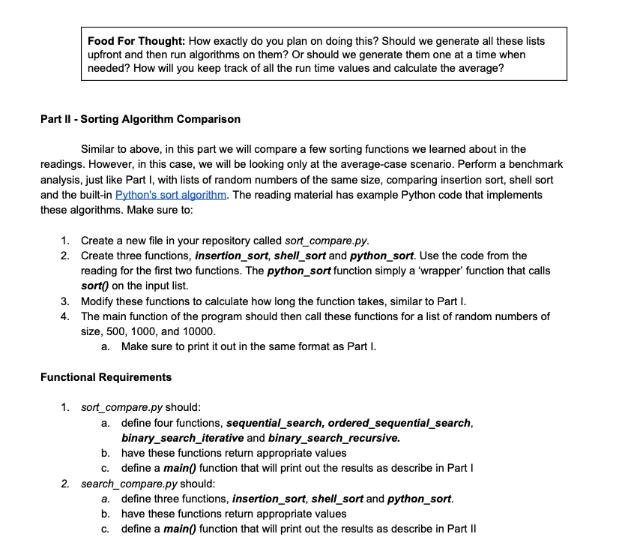Answered step by step
Verified Expert Solution
Question
1 Approved Answer
In this part, we will do a worst-case scenario comparison between the search algorithms in the reading. For searching, a worst-case scenario is searching


In this part, we will do a worst-case scenario comparison between the search algorithms in the reading. For searching, a worst-case scenario is searching for an element that does not exist. Using the sequential and binary search (both iterative and recursive) functions given in the text, generate a random list of positive integers and do a benchmark analysis for each one. Make sure to: 1. Create a new file in your repository called search_compare.py. 2. Create four functions, sequential_search, ordered_sequential_search, binary_search_iterative and binary_search_recursive, and use the code from the section on Sequential and Binary Search to implement them. 3. Modify each function to calculate how long the function takes and to return this along with the result of the search function. a. Do you remember how to return more than one value from a function? 4. The main function of the program should then print how long each function takes, on average. This should be done by generating 100 random input lists (of positive integers) of size 500, 1000, and 10000, and taking the average run time of the 100 lists. a. b. Since we are doing a worst-case analysis, we should search for an element we know will not be in the lists. Our lists should be made up of only positive integers, so for this part of the assignment, we'll search for the -1 element. This should never exist, and hence will be a worst-case scenario. c. Make sure to print out the result in this format: "Sequential Search took %10.7f seconds to run, on average" d. For clarity, you should generate 100 separate lists of size 500, and run each algorithm on these 100 lists. Remember, the binary search functions as well as the ordered sequential search function requires the list to be sorted. Make sure to sort the list (using Python's built in list sort() function; see Part III) before calling the function, so the time it takes to sort the list does not get included in your calculation for how long it took to search. Food For Thought: How exactly do you plan on doing this? Should we generate all these lists upfront and then run algorithms on them? Or should we generate them one at a time when needed? How will you keep track of all the run time values and calculate the average? Part II - Sorting Algorithm Comparison Similar to above, in this part we will compare a few sorting functions we learned about in the readings. However, in this case, we will be looking only at the average-case scenario. Perform a benchmark analysis, just like Part I, with lists of random numbers of the same size, comparing insertion sort, shell sort and the built-in Python's sort algorithm. The reading material has example Python code that implements these algorithms. Make sure to: 1. Create a new file in your repository called sort_compare.py. 2. Create three functions, insertion_sort, shell_sort and python_sort. Use the code from the reading for the first two functions. The python_sort function simply a 'wrapper' function that calls sort() on the input list. Modify these functions to calculate how long the function takes, similar to Part I. The main function of the program should then call these functions for a list of random numbers of size, 500, 1000, and 10000. a. Make sure to print it out in the same format as Part I. 3. 4. Functional Requirements 1. sort_compare.py should: a. define four functions, sequential_search, ordered_sequential_search. binary_search_iterative and binary_search_recursive. b. have these functions return appropriate values c. define a main() function that will print out the results as describe in Part I 2. search_compare.py should: a. define three functions, insertion_sort, shell_sort and python_sort. b. have these functions return appropriate values C. define a main() function that will print out the results as describe in Part II
Step by Step Solution
★★★★★
3.25 Rating (151 Votes )
There are 3 Steps involved in it
Step: 1

Get Instant Access to Expert-Tailored Solutions
See step-by-step solutions with expert insights and AI powered tools for academic success
Step: 2

Step: 3

Ace Your Homework with AI
Get the answers you need in no time with our AI-driven, step-by-step assistance
Get Started


